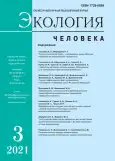Self-Perceived Health and Its Associations with Social Factors and Perceived Environmental Quality in Southern Kazakhstan: a Cross-Sectional Study
- Authors: Alipbekova S.N.1, Buleshov M.A.1
-
Affiliations:
- Khoja Akhmet Yassawi International Kazakh-Turkish University
- Issue: Vol 28, No 3 (2021)
- Pages: 48-53
- Section: Articles
- URL: https://journals.rcsi.science/1728-0869/article/view/64424
- DOI: https://doi.org/10.33396/1728-0869-2021-3-48-53
- ID: 64424
Cite item
Full Text
Abstract
Full Text
##article.viewOnOriginalSite##About the authors
Sandugash N. Alipbekova
Khoja Akhmet Yassawi International Kazakh-Turkish University
Email: sandu-92@mail.ru
PhD student Turkistan, Kazakhstan
Myrzatai A. Buleshov
Khoja Akhmet Yassawi International Kazakh-Turkish UniversityTurkistan, Kazakhstan
References
- Abikulova A. K., Tulebaev K. A., Akanov A. A., Turdalieva B. S., Kalmahanov S. B., Kumar A.B., Izekenova A. K., Mussaeva B. A., Grjibovski A. M. Inequalities in self-rated health among 45+ year-olds in Almaty, Kazakhstan: a cross-sectional study. BMC Public Health. 2013, 13, 654.
- Aubin H. J., Ali Oicheih L., Gabriel S., Berlin I. Association of smoking reduction and mortality: protocol for a systematic review and meta-analysis of longitudinal observational studies. BMJ Open. 2021 Jan 20, 11 (1), e039483.
- Bircher J., Kuruvilla S. Defining health by addressing individual, social, and environmental determinants: new opportunities for health care and public health. J Public Health Policy. 2014, 35, pp. 363-386.
- Bobak M., Pikhart H., Hertzman C., Rose R., Marmot M. Socioeconomic factors, perceived control and self-reported health in Russia: a cross-sectional survey. Soc Sci Med. 1998, 47, pp. 269-279.
- Bobak M., Pikhart H., Rose R., Hertzman C., Marmot M. Socioeconomic factors, material inequalities, and perceived control in self-rated health: cross-sectional data from seven post-communist countries. Soc Sci Med. 2000, 51, pp. 1343-1350.
- Buka S. L., Rosenthal S. R., Lacy M. E. Epidemiological Study Designs: Traditional and Novel Approaches to Advance Life Course Health Development Research. In: Halfon N., Forrest C., Lerner R., Faustman E. (eds). Handbook of Life Course Health Development. Springer, Cham, 2018.
- Burström B., Fredlund P. Self rated health: Is it as good a predictor of subsequent mortality among adults in lower as well as in higher social classes? J Epidemiol Community Health. 2001, 55, pp. 836-840.
- DeSalvo K. B., Bloser N., Reynolds K., He J., Muntner P: Mortality prediction with a single general self-rated health question. A meta-analysis. J Gen Intern Med. 2006, 21, pp. 267-275.
- Dunn J. R., Walker J. D., Graham J., Weiss C. B. Gender Differences in the Relationship between Housing, Socioeconomic Status, and Self-Reported Health Status. Rev Environ Health. 2021, 19, pp. 177-196.
- Gilmore A. B., McKee M., Rose R. Determinants of and inequalities in self-perceived health in Ukraine. Soc Sci Med. 2002, 55, pp. 2177-2188.
- Idler E. L., Benyamini Y. Self-rated health and mortality: a review of twenty-seven community studies. J Health Soc Behav. 1997, 38, pp. 21-37.
- Jasilionis D., Stankuniene V., Ambrozaitiene D., Jdanov D. A., Shkolnikov V. M. Ethnic mortality differentials in Lithuania: contradictory evidence from census-linked and unlinked mortality estimates. J Epidemiol Community Health. 2012, 66, e7.
- Loretta G. Platts, Christopher J. Gerry. Social inequalities in self-rated health in Ukraine in 2007: the role of psychosocial, material and behavioural factors. Eur J Public Health. 2017, 27, pp. 211-217.
- Martikainen M. G., Aromaa A., Heliovaara M., Dlaukka T., Knekt P., Maatele J., Lahelma E. Reliability of perceived health by sex and age. Soc Sci Med. 1999, 48, pp. 1117-1122.
- McCormack G. R., Cabaj J., Orpana H., Lukic R., Blackstaffe A., Goopy S., Hagel B., Keough N., Martinson R., Chapman J., Lee C., Tang J., Fabreau G. A scoping review on the relations between urban form and health: a focus on Canadian quantitative evidence. Health Promot Chronic Dis Prev Can. 2019, 39, pp. 187-200.
- Ou J. Y., Peters J. L., Levy J. I. et al. Self-rated health and its association with perceived environmental hazards, the social environment, and cultural stressors in an environmental justice population. BMC Public Health. 2018, 18, 970.
- Salgado M., Madureira J., Mendes A. S. et al. Environmental determinants of population health in urban settings. A systematic review. BMC Public Health. 2020, 20, p. 853.
- Stanojevic Jerkovic O., Sauliune S., Sumskas L., Birt C. A., Kersnik J. Determinants of self-rated health in elderly populations in urban areas in Slovenia, Lithuania and UK: findings of the EURO-URHIS 2 survey. Eur J Public Health. 2017, 27 (suppl 2), pp. 74-79.
- Stelemekas M., Manthey J., Badaras R., Casswell S., Ferreira-Borges C., Kalediene R., Lange S., Neufeld M., Petkeviciene J., Radisauskas R., Room R., Telksnys T., Zurlyte I., Rehm J. Alcohol control policy measures and allcause mortality in Lithuania: an interrupted time-series analysis. Addiction. 2021 Mar 10. doi: 10.1111/add.15470. (In press)
- Supiyev A., Nurgozhin T., Zhumadilov Z., Sharman A., Marmot M., Bobak M. Levels and distribution of self-rated health in the Kazakh population: results from the Kazakhstan household health survey 2012. BMC Public Health. 2014, 14, 768.
Supplementary files







